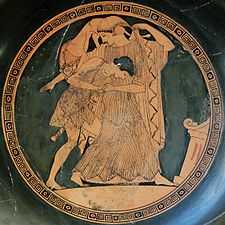Douris (vase painter)

Peleus abducts
Thetis, who is shape-shifting into a lioness to fight back, medallion of a cup of Phase IV, border with double meander, Cabinet des médailles, BNF (Inv. 539)
Douris (Greek: Δοῦρις Douris) was an ancient Athenian red-figure vase-painter and potter active ca. 500 to 460 BCE.
Work
He began his career painting for the potters Kleophrades and Euphronios, before beginning a long collaboration with the potter Python. He signed 39 vases as a painter, also one as a potter and painter,[1] and one vase as a potter only.[2] Between 250 and 300 vases are ascribed to him.[3] The majority of these vases are kylixes, i.e. cups. His name seems to have been popular, since one finds it on other vases: it is reproduced on a cup by Onesimos.[4] On the basis of these signatures, his kalos inscriptions, and of the subsidiary decoration of the vases, the art historian John Beazley divided his career into four principle periods:
Period 1
- (Very early and early) Is characterized by a full ornamentation of diverse border motifs. The preferred subjects are the symposium, the komoi (processions of drunks), and warriors. The period is marked out by the use of the kalos-inscription 'Chairestratos'. Beazley suggests that at this time Douris could have worked side by side with Onesimos in the same workshop.

"Hook" collarbone characteristic of the style of Douris, detail of a medaillon of a cup, ca. 480 BCE, Louvre (G 121).
Period 2
- (Early middle) Douris' collaboration with Euphronios ends; from then on, he paints for the potter Python. Chairestratos remains the preferred kalos-inscription. Subsidiary decoration begins to recede, and the majority of the medallions do not have an edge. The favoured subjects are the scenes of youths and athletes. The hand of Douris is made clear from now on by the characteristic use of a kind of hook for the inner end of the collarbone. A characteristic piece of the period of the period is a psykter (wine cooler) decorated with drunken satyrs, reproducing in a grotesque manner the different stages of intoxication.[5]
Period 3
- (Middle) Douris' style is here at its most idiosyncratic. The edges of the medallion are characterized by the alternation of an element of a meander and squares; palmettes decorate the handles of the cup. The kalos-inscriptions 'Hippodamas' become prevalent; Douris' signatures become scarcer. Douris returns to the scenes of the symposium, and to depictions of warriors and school-scenes. A characteristic period of this period is the cup known as of the "pieta of Memnon": Eos carries the body of her son Memnon, killed by Achilles during the Trojan War.[6]
Period 4
- (Late) Douris returns to a full ornamentation. The borders sometimes retain the period-3 ('Hippodamas-type') border of alternating stopt maeanders and saltire crosses, but gradually revert to the common type; the palmettes on the handles become complicated and of the motifs of the lotus appear in parallel. Douris' signatures disappear altogether and the kalos-inscriptions decrease in frequency; one finds 'Polyphrasmon' and 'HIketes'. The drawing quality degenerates in grace and force.

Signature of Douris ΔΟΡΙΣ ΕΓΡΑΦΣΕΝ, detail of the cup called "pieta of Memnon", c. 490-480 BCE, Louvre (G 115).
References
- ↑ A kantharos, Bruxelles A 718. Cf. Beazley, Attic Red-Figure Vase-Painters (2nd edition, 1963), 445, 256. Illustration on Perseus.
- ↑ A globular aryballos, Athens 15375. ARV2, 447, 274.
- ↑ Boardman suggests "some three hundred" (op. cit., p. 137); Dyfri Williams indicates "around 250", Greek Vases, British Museum Press, 1999 (1st edition 1985), p. 77.
- ↑ Brunswick, College Bowdoin, 1930.1. ARV2, 328, 114. Illustration on Perseus.
- ↑ London E 768. ARV2, 446, 262. Illustration on the British Museum website.
- ↑ Louvre G 115. ARV2, 434, 74. Illustration on the Louvre website.
Sources
- John Beazley, "Attic Red-figure Vase-painters". Second edition, Oxford: The Clarendon Press, 1963.
- John Boardman. Athenian Red Figure Vases: The Archaic Period: A Handbook. London: Thames and Hudson, 1975.
- Diana Buitron-Oliver. Douris. A Master-Painter of Athenian Red-Figure Vases. (in Kerameus, Vol. 9, 2005, online)
- Edmond Pottier and Jane Ellen Harrison (translated by Bettina Kahnweiler). Douris and the Painters of Greek Vases. London: J. Murray, 1908.
- The Getty Museum - Biography of Douris: "One of the most prolific vase-painters known, Douris worked as a vase-painter and occasionally as a potter in Athens in the early 400s B.C. He is known from almost forty signed vases, two of which he also potted. Altogether, almost three hundred vases have been attributed to him. Given that scholars estimate a less than 0.5% survival rate for Greek vases, Douris may have decorated approximately 78,000 vases in his career. Douris primarily decorated red-figure cups, but he also painted a few vessels of other forms and in other techniques, including white-ground. His scenes are about evenly divided between mythology and depictions of everyday life. He worked with a number of potters, including Kleophrades and Euphronios, but he seems to have had a regular collaboration with Python. Onesimos depicted a cup signed by Douris on one of his vases, and there is even an ancient forgery of Douris's signature. These unusual references attest to Douris's significant influence among contemporary vase-painters."
- This article incorporates text translated from the corresponding Greek Wikipedia article.
External links
 |
Wikimedia Commons has media related to Douris. |
|
|---|
| | Wine vessel shapes | |
|---|
| | Tableware | |
|---|
| | Perfume, oil, and wedding shapes | |
|---|
| | Funerary shapes and cultic shapes | |
|---|
| | Storage shapes | |
|---|
| | Utilitarian ceramics | |
|---|
| | Techniques | |
|---|
| | Styles |
- Ancient Greek vase-painting styles
|
|---|
| | Potters and painters | |
|---|
| | Museums noted for pottery | |
|---|
| | Writers and books | |
|---|
| | Special topics in Greek pottery | |
|---|
|


